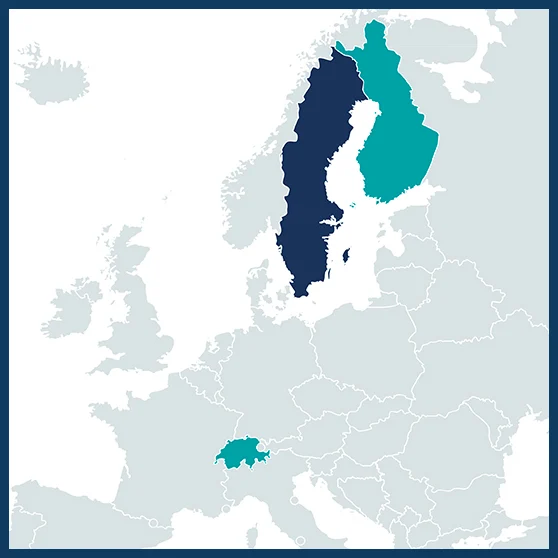01.03.2022 – 31.03.2025
€ 532,044
Håkan TUNÓN
hakan.tunon@slu.se
Coordinator: Urban and Rural Development, Swedish University of Agricultural Sciences, Uppsala, Sweden
Snowchange Cooperative, Lehtoi, Finland
Geography and Sustainability, University of Lausanne, Lausanne, Switzerland
Global Protected and Conserved Areas, International Union for Conservation of Nature (IUCN), Gland, Switzerland

NARROW will examine effective nature conservation and climate change mitigation led by local communities. This will be done by looking at restoration, rewilding, biodiversity, greenhouse gas flux (GHG) and carbon storage of Swedish and Finnish inland waters, wetlands and adjacent meadows and forests. Different sectors of society (e.g. local communities, including Saami people, academics and administrative actors) will be involved. NARROW will examine the success of these locally led restoration projects by bringing together social (oral histories, narratives, values) and ecological (GHG, biodiversity measurements) methods. Ultimately, NARROW will ask the following questions: what are the ecological, cultural, social and spiritual values that inspire local communities to restore and protect different inland water-land systems? Why are they important and how are such values determined and reflected in national and international policy contexts?
Two interrelated hypotheses are posted. The first hypotheses is that diverse, inclusive governance is essential for long term conservation outcomes, this includes local participation and locally led governance. The second is that international environmental targets can be met in the long-term through their various local strategies including restoration, diverse governance situations and their vitality. In this way, NARROW improve the understanding of how effectiveness of local participation and governance contributes to achieving biodiversity targets
NARROW will study the governance contexts of different sites in Finland and Sweden, building on the hypothesis that local communities and their contextualisation is essential for effective and equitable conservation. Interviews and dialogue workshops will be performed in order to seek local access to formal power structures. Through NARROW, the changes in biodiversity and emissions of greenhouse gases in the sites, with an emphasis on cultural keystone species will be assessed. This assessment will primarily rely on existing data and be complemented with data collection. Local knowledge 2020-2021 BiodivRestore call – Funded projects 55 Rewilding area of Salojenneva in western Finland. and values regarding local areas and natural resources will also be analysed. Using narrative research, and “braided knowledge” production, we assess change in specific locations, cultural settings and home areas. These results will then be analysed and linked up with international OECM (other effective area-based conservation measures) guidelines (to understand governance vitality and effectiveness. These results will also be disseminated in national to international policy arenas, e.g. the Swedish Mångfaldskonferensen, and the 2025 IUCN World Conservation Congress.
Several research questions will be answered by NARROW that will contribute to biodiversity conservation at a local, national and international level:
- How do the different governance structures and processes involve local communities and enable them to take decisions for restoration? Who takes decisions, why and how?
- Can we demonstrate added value for biodiversity and ecosystem services through community-led restoration? What is the role of cultural keystone species?
- In addition to the governance data and the biological data, what are the key narratives of “new natures” manifesting in the local places? What role do cultural keystone species play? How do local people express new relationships and values that emerge through restoration and rewilding?
- What is the government vitality and long-term effectiveness of the five sites, and how is this related to the agency, knowledge and narratives of the local actors? How applicable and relevant are the IUCN assessment guidelines to the different local situations and are there lessons learnt from these areas that can be used for further development of these guidelines?
- How can local perspectives inform and influence regional and global policy? Can global policies help to defend, support and recognise local communities?
At the local level, NARROW will make a strong case for integrating views, voices, perspectives and narratives of local communities as key factors in achieving biodiversity conservation outcomes. At the national level, NARROW will engage with Convention on Biological Diversity focal points and report to the World Databases on Protected Areas and OECMs. At the EU level, the results will influence EU policymaking and EU Member States as the target to protect 30% is likely to be included in National Biodiversity Strategy Action Plans. At the international level, NARROW will suggest improvements to the OECM global guidelines.
Our study sites are connected to inland waters. We will focus on five study areas: Koitajoki basin in North Karelia, Salojenneva wetland in Western Finland and Näätämö basin, a Saami home area in Lapland (Finland), and Gredelby pastures/Trunsta marsh and the Voxnadalen Biosphere Reserve, including the Sässman area of Voxnan River, with a lake, wet meadows and pastures (Sweden). We will in these areas conduct interviews and dialogue workshops with the local actors, measurements of greenhouse gas emissions, and biodiversity observations.
- Swedish Environmental Protection Agency (SEPA), Sweden
- Finnish Academy of Sciences (AKA), Finland
- Swiss National Science Foundation (SNSF), Switzerland